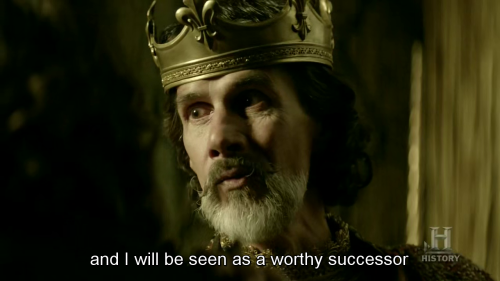ex-libris-blog:Emperor Charles, Count Odo and Princess Gisela, Vikings S03E07 “Paris”The
ex-libris-blog:Emperor Charles, Count Odo and Princess Gisela, Vikings S03E07 “Paris”The show presents an amalgam of the two historical events and three different rulers named ‘Charles’.There were notably two separate sieges of Paris: The first one took place in 845: -The Siege of Paris and the Sack of Paris of 845 was the culmination of a Viking invasion of the kingdom of the West Franks. The Viking forces were led by a Danish chieftain named “Reginherus”, or Ragnar, who traditionally has been identified with the legendary saga character Ragnar Lodbrok. Ragnar’s fleet of 120 Viking ships, carrying thousands of men, entered the Seine in March and proceeded sailing up the river. The West Frankish king Charles the Bald assembled a smaller army in response, but as the Vikings defeated one division, comprising half of the army, the remaining forces retreated. The Vikings reached Paris at the end of the month, during Easter. After plundering and occupying the city, the Vikings finally withdrew after receiving a ransom payment of 7,000 French livres (2,570 kilograms or 5,670 pounds) of silver and gold from Charles the Bald.-Charles the Bald was the King of West Francia (843–77), King of Italy (875–77) and Holy Roman Emperor (875–77, as Charles II). After a series of civil wars that began during the reign of his father, Louis the Pious, Charles succeeded by the Treaty of Verdun (843) in acquiring the western third of the Carolingian Empire. He was a grandson of Charlemagne and the youngest son of Louis the Pious by his second wife, Judith.-The Siege of Paris of 885–86 was part of a Viking raid on the Seine, in the Kingdom of the West Franks. The siege was the most important event of the reign of Charles the Fat, and a turning point in the fortunes of the Carolingian dynasty and the history of France. The siege is the subject of an eyewitness account in the Latin poem Bella Parisiacae urbis of Abbo Cernuus.With hundreds of ships, and possibly tens of thousands of men, the Vikings arrived outside Paris in late November 885, at first demanding tribute. This was denied by Odo, Count of Paris, despite the fact that he only could assemble a couple of hundred soldiers to defend the city. The Vikings attacked with a variety of siege engines, but failed to break through the city walls after some days of intense attacks. The siege was upheld after the initial attacks, but without any significant offence for months thereafter. As the siege went on, most of the Vikings left Paris to pillage further upriver. The Vikings made a final unsuccessful attempt to take the city during the summer, and in October, Charles the Fat arrived with his army.To the frustration of the Parisians who had fought for a long time to defend the city, Charles stopped short of attacking the Viking besiegers, and instead allowed them to sail further up the Seine to raid Burgundy, as well as promising a payment of 700 livres (pounds; 257 kg). Odo, highly critical of this, tried his best to defy the promises of Charles, and when Charles died in 888, Odo was elected the first non-Carolingian king of the Franks.-Charles the Fat also known as Charles III, was the Carolingian Emperor from 881 to 888. The youngest son of Louis the German and Hemma, Charles was a great-grandson of Charlemagne and was the last Carolingian to rule over a united empire.-Charles III called the Simple or the Straightforward (Latin Carolus Simplex) was the King of Western Francia from 898 until 922 and the King of Lotharingia from 911 until 919–23. He was a member of the Carolingian dynasty. In 893 Charles was crowned by a faction opposed to Odo at Reims Cathedral, though he only became the effectual monarch with the death of Odo in 898. In 911, a group of Vikings led by Rollo besieged Paris and Chartres. After a victory near Chartres on 26 August, Charles decided to negotiate with Rollo, resulting in the Treaty of Saint-Clair-sur-Epte. For the Vikings’ loyalty, they were granted all the land between the river Epte and the sea, as well as Brittany, which at the time was an independent country which France had unsuccessfully tried to conquer. Rollo also agreed to be baptised and to marry Charles’ daughter, Gisela.Source: WikipediaImage 1: Charles the BaldImage 2: Charles the FatImage 3: Charles the Simple -- source link
Tumblr Blog : ex-libris-blog.tumblr.com
#history#french history#vikings







